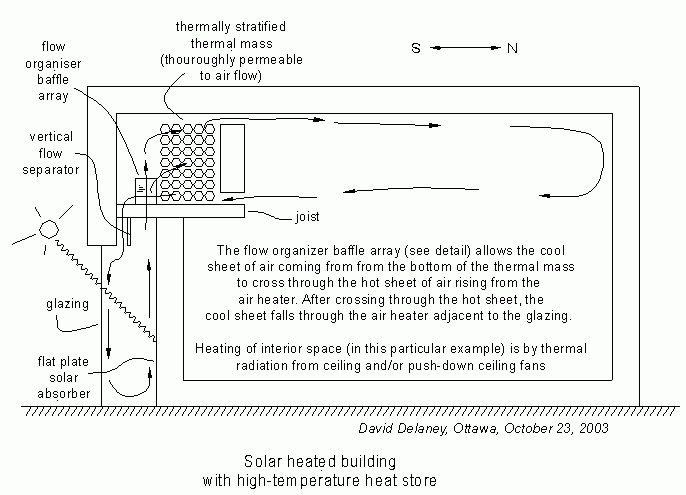
Norman Saunders reduced the energy loss from the solar air heater of his Cliff House [1] by having the cool air enter the air heater from the top and descend next to the glazing. The pattern of the air flow in the Cliff House requires the north-south thickness of the air heater to be greater than the north-south extent of the elevated thermal mass. Here is a way to remove this constraint, and allow the air heater to be much thinner, and/or to allow the north-south extent of the elevated thermal mass to be much larger, or to allow the thermal mass to be positioned more centrally in the building. I believe this idea is new.
A solar air heater and heat store may be constructed without fans or dampers if the heat store is placed above the air heater. At night, the air in the air heater is heavier than the air in the heat store, so there is almost no loss of heat to the air heater. During the day, light hot air rises from the air heater to enter the heat store, gives up energy to the thermal mass of the heat store, then, cooler and heavier, falls into the air heater to be heated again.

It is useful to maintain thermal stratification of the heat store, and to allow the air heater to contribute energy to the heat store at any temperature above the lowest temperature in the heat store. This goal requires a thermal mass which is permeable to air flow in any direction. If hot air from the air heater rises in the heat store by natural convection beside the thermal mass, rather than through it, the hot air will rise to the level at which its temperature equals the temperature of the thermal mass before entering the thermal mass, preserving thermal stratification.
The drawing of the house cross section, above, shows the cool air returning from the heat store descending through the air heater next to the glazing. This arrangement is somewhat unnatural, because it requires the cool sheet of returning air to cross through the sheet of rising hot air. It would be easier to arrange the air flows so that the hot air rises adjacent to the glazing, and avoid the need for the air sheets to cross, but this arrangement would greatly increase the heating of the glazing, and reduce the efficiency of the air heater. The flow organizer baffle array indicated in the drawing above, and shown in detail below, allows the two moving air sheets to cross through each other without mixing.

It is important to avoid turbulent flow of the cool air as it drops away from the ceiling cool slot. To promote sheet-like flow of the cool air, a section of bare floor has been provided just south of the vertical hot air duct sections. This short section of bare floor should help to smooth out turbulence caused by passing around the duct sections. Just below the joists, and therefore uninterrupted by them, a duct formed by the vertical flow separator and the south wall of the air heater performs further flow smoothing--see drawing below.
The vertical flow separator also allows the rising hot air sheet to pile up (pile down?) as it splits up to pass up around the floors of the crossing cold channels, without protruding south into the descending cold sheet.

In Norman Saunders's Cliff House [1] an air heater provided hot air by natural convection to a thermally stratified elevated heat store. He also arranged that the returning cool air would fall through the air heater next to the glazing. Saunders avoided crossing the hot and cool air sheets by making the north-south dimension of the air heater larger than the north-south dimension of the thermal mass. He positioned the hot air slot at the north extremity of the air heater, north of the thermal mass, and the cool air slot at the south extremity near the glazing, south of the thermal mass. The air-flow organizer described here allows the hot and cool air sheets to cross through each other, providing greater flexibility than Saunders had in choosing the thickness of the air heater and the size and position of the thermal mass.
[1] William A. Shurcliff, "Super solar houses -- Saunders's 100%
solar,
low-cost designs", pp. 89-118, Brick House Publishing Company, Andover,
Mass., 1983. The chapter on the Cliff House is reproduced on the web at
http://www.oocities.org/~dmdelaney/shurcliff/shurcliff-saunders-1.pdf
[2] For a house concept incorporating the flow organizer, see Thermosyphon solar air heater and attic heat store for 100% solar heating ,
http://oocities.com/davidmdelaney/thermal-cs/thermal-crawl-space-1.html
[3] [January 2006] Gary Reysa has built and tested a thermal model of the flow organizer. See http://www.builditsolar.com/Experimental/FlowOrganizer/FlowOrg.htm